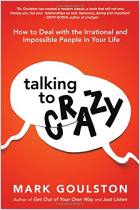Acesse a sua conta getAbstract para obter o resumo!

Acesse a sua conta getAbstract para obter o resumo!
Kate Abramson
On Gaslighting
Princeton UP, 2024
Sobre o que é?
“Gaslighting,” Merriam-Webster’s “word of the year” in 2022, is a much-discussed social phenomenon, but what does it actually mean?
Recommendation
“Gaslighting,” Merriam-Webster’s “word of the year” in 2022, is a term that gets bandied about when one person questions another’s credibility. However, gaslighting is a much more specific, nefarious behavior. With clarity, sensitivity, and academic rigor, philosopher Kate Abramson conducts a deep dive into its characteristics, motives, and psychological damage. She illustrates how gaslighters undermine their targets’ confidence and independence, and how gaslighting often reinforces oppressive ideologies such as sexism and racism. Abramson notes that most gaslighters are men, while their victims are most commonly women, and her use of pronouns throughout her book is representative of a textbook case. However, anyone can become the victim of a gaslighter. People who’ve experienced gaslighting — and those who support them — will appreciate the insight and validation Abramson’s account provides.
Take-Aways
- Gaslighting is a form of emotional manipulation that causes its victims to mistrust their own judgment.
- The word “gaslighting” originates from a 1944 film in which a man attacks his wife’s sanity.
- Gaslighting occurs during multiple interpersonal interactions over time.
- Gaslighters care deeply about what other people think, and they can’t handle challenges to their views.
- Gaslighters twist love and trust into tools of manipulation.
- Gaslighters silence their victims by creating conditions in which their words lack power.
- Gaslighting serves as a tool to reinforce systemic oppression and deny people’s lived experiences.
- Targets of gaslighting can suffer profound damage to their mental health and independence.
- To recover from gaslighting, the target needs to recognize the betrayal and relearn to trust.
Summary
Gaslighting is a form of emotional manipulation that causes its victims to mistrust their own judgment.
The word “gaslight” has become ubiquitous over the past decade, but people tend to use the term too broadly, misunderstanding the true meaning of gaslighting. As a verb, “gaslight” means to discredit another’s processes of thought, perceptions, and judgment by means of emotional manipulation. Over time, the targets of gaslighting begin to doubt their own perceptions, reactions, memories, and beliefs.
Gaslighting interferes with victims’ ability to govern themselves. They gradually internalize the belief that they can’t properly perceive reality, make decisions, or form assessments of their own experiences. This self-distrust can lead victims to grant their perpetrators additional power, as they come to believe that they need their gaslighters to assist in treating and managing their condition.
“Gaslighters aim to fundamentally undermine their targets as deliberators and moral agents.”
If you’ve never been gaslit and struggle to understand what victims endure, the following exercise can help you to relate: Think of a major negative experience you’ve had, one that troubled you for at least a month. Then imagine people — including your nearest and dearest — denying your experience and minimizing its impact instead of validating that you were experiencing difficulty. When you protest, they accuse you of overreacting, and the very fact of your enduring the ordeal is twisted into “proof” that the experience wasn’t significant. They call you crazy for seeing it differently, question your ability to judge the situation accurately, and tell you any problem lies within you.
The word “gaslighting” originates from a 1944 film in which a man attacks his wife’s sanity.
In the 1944 film Gaslight, the antagonist, Gregory, engages in manipulative moves to convince his wife, Paula, and her friends that she’s losing her mind, with the objective of having her committed so Gregory can steal her gems. In several scenes, Gregory switches on the attic lights so he can secretly search for Paula’s jewels, which causes the gaslights in the rest of the house to dim. To hide his visits to the attic — and to undermine Paula’s sanity — Gregory repeatedly tells her she’s imagining the dimming of the gaslights.
“Suffering on account of [gaslighting] is not a sign of fragility, weakness, or an exceptionally damaged psyche; it’s a sign of being human.”
Gregory is a fictional character, and in real life, gaslighters don’t often have specific objectives, such as stealing jewels. They might not even consciously aim to drive their victims “crazy.” However, gaslighting does cause its targets to begin to doubt their own sanity, and it can gradually erode the mental health of otherwise psychologically healthy individuals.
Gaslighting occurs during multiple interpersonal interactions over time.
“That’s crazy,” “Don’t be so sensitive,” “Don’t be paranoid. I was just joking!” “You’re imagining things,” or “I’m worried. I think you’re not well.” These are all common phrases in a gaslighter’s vernacular. But a single instance — for example, accusing someone of overreacting — doesn’t amount to gaslighting. Rather, gaslighting occurs over an extended period of time, as part of an ongoing pattern of manipulative interpersonal interactions.
“The pervasiveness of gaslighting, over a long time, often from multiple voices, is key to how and why it works.”
Gaslighting must occur over time so that gaslighters can conceal their malfeasance; the gradual, step-by-step nature of the manipulation makes it difficult for targets to recognize what’s happening and mount a defense. And the consistent, iterative quality of gaslighting contributes to its power: When someone you trust consistently denies the reality of your experiences, you slowly start to doubt your own perceptions and deliberative capacities.
Gaslighters care deeply about what other people think, and they can’t handle challenges to their views.
Gaslighters can have multiple, overlapping aims. If you’re trying to understand a gaslighter’s motivation, ask yourself what the person stands to gain if the gaslighting works. Often, gaslighters struggle to tolerate challenges to their perspective. These difficulties tend to be limited to certain contexts. For example, a man who can accept an older male colleague disagreeing with him but who feels unbearably anxious when a female peer disagrees with him might respond by attempting to gaslight her.
When you encounter a person who holds views that diverge from your own, you have several options: You might respond with curiosity, note the difference, attempt to find common ground, try to persuade the other of your perspective through rational argument, or let the person know why their perspective triggers feelings of uneasiness in you. Alternatively, you could respond in a number of unethical ways to gain the person’s agreement, which are not in themselves gaslighting, though still morally disturbing. These include lying, guilt-tripping, making threats, or engaging in blackmail or bribery. However, gaslighters respond by engaging in a specific pattern of behavior that, over time, makes their targets doubt their ability to form their own judgments.
Gaslighters often go to considerable lengths to ensure others don’t agree with their victims, which demonstrates that gaslighters are deeply invested in what others think. Gaslighters would prefer to believe that those who argue with them are “crazy,” rather than admit that their opponents could possibly have valid views. And a gaslighter, not content with merely disagreeing with the target, feels compelled to ensure that the target, too, believes the gaslighter’s perspective. A gaslighter is sometimes driven by a complex urge to maintain a relationship with the target, but only on the gaslighter’s terms and while maintaining a position of power.
Gaslighters twist love and trust into tools of manipulation.
Gaslighters use many tools to deceive and disempower their targets. For example, to increase their targets’ vulnerability, gaslighters employ isolation, both emotional — such as telling their targets that they can’t trust anyone else — and literal. And in order to hide their manipulations, gaslighters often feign fallibility, pretending to entertain the notion that they might be wrong and falsifying a willingness to consider alternative perspectives.
Gaslighters also subvert their targets’ most positive qualities — including love and trust. By weaponizing these virtues, gaslighters lead their targets to question their own thoughts and feelings, creating intense emotional distress. The exploitation and destabilization of trust are core to gaslighting, in ways that go beyond that of a garden-variety liar. Gaslighters don’t just violate their targets’ trust; they do so in a way that fractures their targets’ very capacity to trust, so targets can’t trust even in themselves.
“Gaslighting doesn’t eliminate its target’s ability to trust: It makes a devastated mess of it.”
It can seem unimaginable that someone you love would act against your best interests, so if you have a close relationship with a gaslighter, you might fail to recognize that you’re being gaslit. And it’s natural to want your loved one to think well of you, so if a gaslighter calls you “crazy” or “paranoid,” you may begin to doubt yourself. A gaslighter might also threaten to end your relationship as a means of gaining control.
The movie Gaslight offers a potent example of this weaponization of love and trust. When a friend calls to the couple’s home to visit Paula, Gregory sends the friend away, without conferring with Paula. When Paula objects, Gregory falsely insinuates that Paula herself had earlier asked to have the friend sent away and now is changing her mind. Gregory then pretends to be insulted and hurt that Paula doesn’t trust him to speak for her. The fact that she loves and trusts him — and believes he loves her — places Paula in an impossible position. She becomes dejected and mutters, “It doesn’t matter.”
Gaslighters silence their victims by creating conditions in which their words lack power.
Philosopher Rae Langton coined the term “silencing” to describe the fact that people in certain circumstances can’t use language in the same way others do. For example, in a respectful interaction, when someone opens up about a first-hand experience, most people would treat the speaker as a credible narrator.
However, gaslighters characterize their targets’ words as mere evidence of their “acting out” or as products of a “paranoid” or “oversensitive” disposition. Gaslighters reduce their targets’ words to utterances that indicate a mental state and nothing more, while slowly conditioning their victims to view themselves in the same way — thus silencing them.
Gaslighting serves as a tool to reinforce systemic oppression and deny people’s lived experiences.
Gaslighting frequently occurs in close relationships, such as between spouses or family members. But it can occur in other settings, such as the workplace — for example, to undermine someone who reports improper behavior or workplace harassment. Often, the victim is a member of a subjugated group or faces discrimination. For example, a white man might gaslight a nonwhite colleague who attempts to call out his discriminatory behavior in the workplace.
“Gaslighting is a fiendishly brilliant tool for reinforcing racism, sexism, and other forms of systematic subjugation.”
Gaslighting isn’t inherently a racist or sexist activity, but it does commonly serve as a tool to buttress systematic subjugation, including racism and sexism. Men tend to engage in gaslighting more often than women, and the targets of gaslighting tend to be women more often than men, and people of color more often than white people. Historian Elaine Frantz points out that gaslighting introduces doubt and confusion, clouding people’s perceptions of the oppressions they encounter. Individuals who have come to distrust their own perceptions and judgment will struggle to identify patterns in their experiences and identify them as, for example, racism.
Targets of gaslighting can suffer profound damage to their mental health and independence.
Targets of gaslighting often lose faith in their ability to tell right from wrong and stop seeing themselves as entitled to their own emotions; thus, gaslighters rob their targets of the ability to advocate for themselves. For example, if you believe your anger toward your spouse to be illegitimate, then you won’t seek an apology or a change in behavior. When targets of gaslighting no longer believe that they are entitled to their own emotions, their self-worth begins to deteriorate, and their repressed emotions often turn inward, manifesting in mental health issues. The final stage of gaslighting is severe clinical depression.
“When gaslighting works well, its target ends up feeling ‘carved up,’ ‘nobody,’ lost.”
Moreover, gaslighting can cause its targets to become complicit in their own torment. Imagine that a gaslighter accuses you of believing “crazy” things. You might begin to work against your own best interests by seeking evidence that your abuser is right: If you can establish that the gaslighter is correct — meaning that what you believe or have said is, in fact, “crazy” — then you can no longer be labeled as “crazy.” Thus, targets of gaslighting can participate in their own abuse, and they often feel at fault for their own suffering — until they begin to see the gaslighting for what it is.
To recover from gaslighting, the target needs to recognize the betrayal and relearn to trust.
Once targets of gaslighting recognize what has happened, their self-assurance and self-possession may begin to return. They might also experience a surge of repressed emotions, such as rage, which may give way to underlying feelings, such as disappointment.
“Trusting well isn’t so much a power…as it is a skill — a skill of affective regulation, interpersonal insight, and negotiation, of setting apt normative expectations and revising them where called for, of perception, of moral reflection.”
Gaslighting involves an egregious violation of trust, and people who’ve experienced gaslighting understandably often feel as though they’ve lost the ability to trust. Trust is a vital skill required for anyone who hopes to coexist with others, and gaslighting victims must work to rebuild it. But the pathway back to trust isn’t as straightforward as the pathway toward rebuilding other skills a person might lose over time, such as, say, relearning a second language you’ve forgotten. Sometimes, victims of gaslighting oscillate between childlike presentations of trust, in which they treat others as rescuers or idealized parents, and utter mistrust.
If you’ve been a victim of gaslighting, friends and therapists can help support you as you learn to trust people again. It’s imperative that you start talking about what’s happened to you. As the psychoanalyst Sigmund Freud points out, being able to name your experience — to articulate specifically what you’ve endured and the effects of your traumatic experience — is an essential step in your recovery.
About the Author
Kate Abramson is an associate professor of philosophy at Indiana University Bloomington. Her research interests include contemporary ethics and philosophical feminism.
This document is restricted to personal use only.




























Comment on this summary